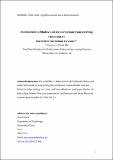Files in this item
Children infer affiliative and status relations from watching others imitate
Item metadata
| dc.contributor.author | Over, Harriet | |
| dc.contributor.author | Carpenter, Malinda | |
| dc.date.accessioned | 2016-12-21T00:31:53Z | |
| dc.date.available | 2016-12-21T00:31:53Z | |
| dc.date.issued | 2015-11 | |
| dc.identifier | 149563322 | |
| dc.identifier | 050cd2db-4187-420e-a7a6-57d6f7944063 | |
| dc.identifier | 84943598601 | |
| dc.identifier | 000362911400006 | |
| dc.identifier.citation | Over , H & Carpenter , M 2015 , ' Children infer affiliative and status relations from watching others imitate ' , Developmental Science , vol. 18 , no. 6 , pp. 917-925 . https://doi.org/10.1111/desc.12275 | en |
| dc.identifier.issn | 1363-755X | |
| dc.identifier.other | ORCID: /0000-0003-3983-2034/work/64697991 | |
| dc.identifier.uri | https://hdl.handle.net/10023/9996 | |
| dc.description | Harriet Over was supported by the Economic and Social Research Council (grant number ES/K006702/1). | en |
| dc.description.abstract | We investigated whether young children are able to infer affiliative relations and relative status from observing others’ imitative interactions. Children watched videos showing one individual imitating another and were asked about the relationship between those individuals. Experiment 1 showed that 5‐year-olds assume individuals imitate people they like. Experiment 2 showed that children of the same age assume that an individual who imitates is relatively low in status. Thus, although there are many advantages to imitating others, there may also be reputational costs. Younger children, 4-year-‐olds, did not reliably make either inference. Taken together, these experiments demonstrate that imitation conveys valuable information about third-‐party relationships and that, at least by the age of five, children are able to use this information in order to infer who is allied with whom and who is dominant over whom. In doing so, they add a new dimension to our understanding of the role of imitation in human social life. | |
| dc.format.extent | 250803 | |
| dc.language.iso | eng | |
| dc.relation.ispartof | Developmental Science | en |
| dc.subject | BF Psychology | en |
| dc.subject | NDAS | en |
| dc.subject.lcc | BF | en |
| dc.title | Children infer affiliative and status relations from watching others imitate | en |
| dc.type | Journal article | en |
| dc.contributor.institution | University of St Andrews. School of Psychology and Neuroscience | en |
| dc.contributor.institution | University of St Andrews. Centre for Social Learning & Cognitive Evolution | en |
| dc.identifier.doi | https://doi.org/10.1111/desc.12275 | |
| dc.description.status | Peer reviewed | en |
| dc.date.embargoedUntil | 2016-12-20 |
This item appears in the following Collection(s)
Items in the St Andrews Research Repository are protected by copyright, with all rights reserved, unless otherwise indicated.

